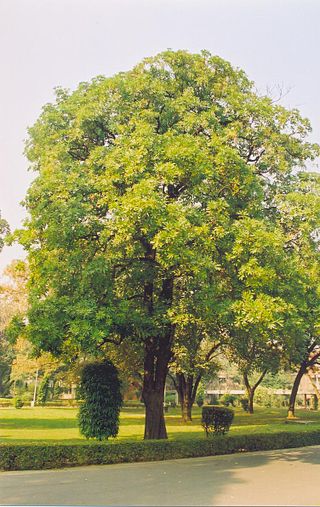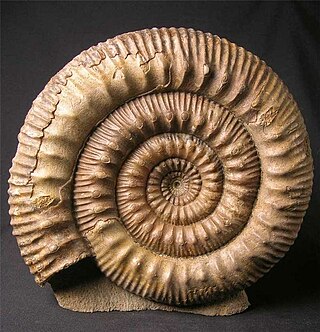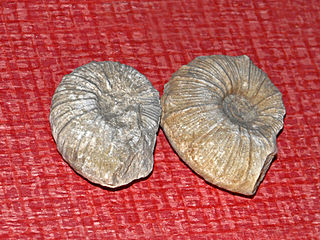
Alstonia is a widespread genus of evergreen trees and shrubs, of the family Apocynaceae. It was named by Robert Brown in 1811, after Charles Alston (1685–1760), professor of botany at Edinburgh from 1716 to 1760.
The Muschelkalk is a sequence of sedimentary rock strata in the geology of central and western Europe. It has a Middle Triassic age and forms the middle part of the three-part Germanic Trias lying above the older Buntsandstein and below the younger Keuper. The Muschelkalk ("mussel-chalk") consists of a sequence of limestone and dolomite beds.

Stephanoceras is an extinct genus of Stephanoceratoid ammonite which lived during the Bajocian. It is the type genus of the family Stephanoceratidae.

The gastropod shell is part of the body of a gastropod or snail, a kind of mollusc. The shell is an exoskeleton, which protects from predators, mechanical damage, and dehydration, but also serves for muscle attachment and calcium storage. Some gastropods appear shell-less (slugs) but may have a remnant within the mantle, or in some cases the shell is reduced such that the body cannot be retracted within it (semi-slug). Some snails also possess an operculum that seals the opening of the shell, known as the aperture, which provides further protection. The study of mollusc shells is known as conchology. The biological study of gastropods, and other molluscs in general, is malacology. Shell morphology terms vary by species group.

Australiceras is an extinct ammonite genus from the upper part of the Early Cretaceous, Aptian stage, included in the family Ancyloceratidae.
Xenoceltites is an extinct genus of ceratite ammonoid found worldwide in the Lower Triassic.

Barremites is an ammonoid cephalopod genus belonging to the family Desmoceratidae, that lived during the Hauterivian and Barremian stages of the Early Cretaceous.
Frechites is an early Triassic ammonite, a kind of cephalopod with an external shell, included in the ceratitid family Beyrichitidae.

Ammonitina comprises a diverse suborder of ammonite cephalopods that lived during the Jurassic and Cretaceous periods of the Mesozoic Era. They are excellent index fossils, and it is often possible to link the rock layer in which they are found to specific geological time periods.

Placenticeras is a genus of ammonites from the Late Cretaceous. Its fossils have been found in Asia, Europe, North and South America.

The Tarphycerida were the first of the coiled cephalopods, found in marine sediments from the Lower Ordovician to the Middle Devonian. Some, such as Aphetoceras and Estonioceras, are loosely coiled and gyroconic; others, such as Campbelloceras, Tarphyceras, and Trocholites, are tightly coiled, but evolute with all whorls showing. The body chamber of tarphycerids is typically long and tubular, as much as half the length of the containing whorl in most, greater than in the Silurian Ophidioceratidae. The Tarphycerida evolved from the elongated, compressed, exogastric Bassleroceratidae, probably Bassleroceras, around the end of the Gasconadian through forms like Aphetoceras. Close coiling developed rather quickly, and both gyroconic and evolute forms are found in the early middle Canadian.

Lepidobotryaceae is a family of plants in the order Celastrales. It contains only two species: Lepidobotrys staudtii and Ruptiliocarpon caracolito.

Collignociceras is a strongly ribbed and tuberculate, evolute ammonite from the Turonian of the western U.S. and Europe belonging to the ammonitid family Collignoniceratidae. The genus is named after the French paleontologist Maurice Collignon. The type is Collignoniceras woollgari, named by Mantell in 1822 for specimens from Sussex, England.

Clionites is a genus of the clydonitoidean family Clionitidae, and its type. The shell is evolute so as to expose all whorls which are covered with generally bifurcating sigmoidal ribs. The suture is ceratitid with two lateral lobes.
Liroceras is a genus of nautiloid cephalopod. It is the type genus of the clydonautiliacean family, Liroceratidae, and is characterized by a rapidly expanding, subglobular, nautiliconic shell with a reniform whorl section, small umbilicus, essentially straight sutures, and a siphuncle with a variable but not marginal position.

Neocomites is a genus of ammonite from the Lower Cretaceous, Berriasian to Hauterivian, and type genus for the Neocomitidae.

Spitidiscus is a genus of ammonites placed in the family Holcodiscidae.

Holcodiscidae is an ammonite family placed in the superfamily Desmoceratoidea.

Holcodiscus is an extinct ammonite genus placed in the family Holcodiscidae. Species in this genus were fast-moving nektonic carnivores. The type species of the genus is Ammonites caillaudianus.

Ophiceras is an extinct genus of smooth, evolute ceratitid ammonites from the Griesbachian, with a rounded venter. Fossils of the genus have been found in Armenia, Azerbaijan, China, Greenland, and India.















